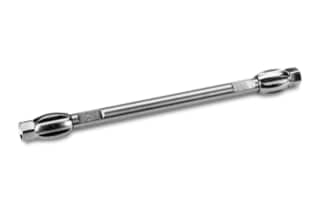
|
Chemistry |
C18 |
|
Separation Mode |
Reversed Phase |
|
Particle Substrate |
Hybrid |
|
pH Range Min |
1 pH |
|
pH Range Max |
12 pH |
|
Maximum Pressure |
6000 psi (415 Bar) |
|
Endcapped |
Yes |
|
Silanol Activity |
Low |
|
Molecular Weight Range Min |
1000 |
|
Molecular Weight Range Max |
15000 |
|
Particle Shape |
Spherical |
|
Particle Size |
3.5 µm |
|
Endfitting Type |
Waters |
|
Pore Size |
300 Å |
|
QC Tested |
Peptide |
|
Format |
Column |
|
Surface Area |
185 |
|
System |
HPLC |
|
Particle Technology |
BEH |
|
USP Classification |
L1 |
|
Inner Diameter |
2.1 mm |
|
Length |
100 mm |
|
Carbon Load |
18 % |
|
UNSPSC |
41115709 |
|
Application |
Peptide |
|
Brand |
XBridge |
|
Product Type |
Columns |
|
Units per Package |
1 pk |

XBridge Peptide BEH C18 Column, 300Å, 3.5 µm, 2.1 mm X 100 mm, 1K - 15K, 1/pk
With low pH stability and extremely little column bleed, the XBridge Peptide BEH C18 Column allows you to analyze samples for proteomics over a broad pH range. The wide-pore (300) tri-functionally bound BEH particle used in the lab apparatus can also be used for protein characterization and peptide synthesis. The XBridge BEH300 C18 Peptide Separation Technology (PST) columns have been QC tested and optimized for peptide separations.
To benefit from the Protein Separation Technology of the analytical column, which incorporates BEH technology and uses synthetic particles to deliver the best quality and consistent performance, add the XBridge Peptide BEH C18 Column to your collection of lab supplies.
A cGMP, ISO 9002 accredited plant produced the packing materials for the XBridge Peptide BEH C18 columns using an ultra-pure reagent to produce good peak shape, high efficiency, and exceptional stability. Each batch of XBridge Peptide BEH C18 Column material undergoes a peptide separation; the results are held to precise specification ranges. This is done to achieve high, reproducible peptide separation performance. Each column is tested, and a Performance Test Chromatogram, as well as a Certificate of Acceptance, are included in the package with each column.
The XBridge Peptide BEH C18 Column underwent quality control verification using a peptide map to ensure the stability of peptide separation procedures. This is accomplished by utilizing established, state-of-the-art bonding procedures for the C18 ligand, which provide reproducible outcomes for a variety of samples utilized in proteomics, protein characterization, and peptide synthesis. You may depend on the analytical column's consistency as a result, getting consistent separations of synthetic peptides and protein digests from batch to batch. Particle structure and bonding chemistry are guaranteed to be stable from pH 1 to 12 and at high temperatures, thanks to the fabrication procedures used for the lab equipment.
By looking through our website or the booklet, you can find a full range of Waters products and shop for lab equipment to make sure all of your lab requirements are satisfied. You should also take a look at Cytochrome C Digestion Standard, which was created by breaking down Bovine Heart Cytochrome C (Uniprot # P62894) with sequencing-grade trypsin. According to tight quality control standards that are attested to on the certificate of analysis that is supplied, each batch of the digestion standard is created. Applications for protein digestion standards range from evaluating and benchmarking HPLC and UPLC columns to assessing the performance of mass spectrometry and chromatography equipment.
How Does Resolution Function in Chromatography?
Because resolution depends on peak width and retention time, both of which are essential components of the chromatographic process, resolution can be used to enhance separations.